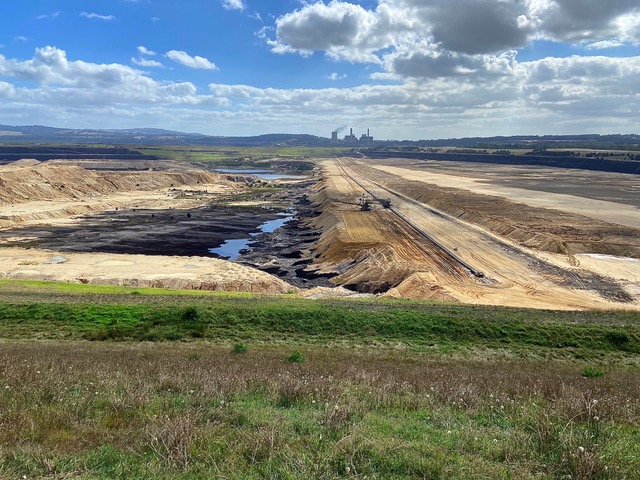This is the third article in a series of four.
The first article covered the “Geology of the Latrobe Valley” in which we learnt:
- the brown coal resources of the Latrobe Valley are vast and extensive,
- there are lots of coal with very little covering material,
- the coal is very “young”, is physically neither rock nor clay and behaves uniquely,
- the brown coal has significant jointing (zones of weakness),
- the geology at each site is unique with some having underlying aquifers requiring consideration,
- this situation is unique in the world,
- brown coal has a low resistance to water pressure,
- brown coal “weathers” exceptionally well and does not easily erode.
The second article covered the “Impacts from Mining” in which we learnt:
- Digging any hole creates horizontal relaxation which can lead to individual batter[1] destabilisation.
- The predominate “highly dispersive” clays overlying the brown coal deposits can also lead to individual batter destabilisation.
- The local groundwater table is lowered by mining which creates conditions where water ingress into coal batters may precipitate movement.
- Slopes at the bottom of coal and the immediate underlying material properties can have a significant impact on batter stability. The properties of the immediately underlying material can be significantly adversely impacted by water saturation and make a stable batter unstable.
- The need to maintain a balance between aquifer pressures and the weight of overlying materials is fundamentally important to floor and batter stability at Hazelwood and Loy Yang voids. There is no such issue at Yallourn. Aquifer levels will increase over time once pumping ceases.
[1] A batter is the sloped section of the pit wall. It can be either an individual batter (slope) between benches or the overall slope of all the individual batters and benches. A bench is a near level surface used for access and the running of services.
In this article we will discuss what is required to create safe, stable and sustainable conditions after mining ceases.
SAFE:
Whether the post rehabilitated mine void is accessible by the public or not, there are minimum standards required by legislation. All areas above the water level (which if it is dry will include the floor of the mine void) must be maintained in a state to minimise the spread of fire. This will require slopes to be accessible for slashing. This is generally recognised as requiring a slope of 3 units horizontal to 1 unit vertical to be safely tractorable.
Where any of the batters contain exposed coal, this will need to be effectively covered to prevent fire from getting established. We have seen and experienced how difficult it can be to extinguish a fire if it gets a hold in an area that does not have an existing highly reticulated fire protection system.
It is important to ensure that our environment is not adversely impacted by toxicity, including but not limited to:
- water quality where water bodies are created within the mine voids,
- groundwater and aquifer contamination,
- run-off to local waterways, and
- soil contamination.
Protection is enforced against these adverse outcomes under CFA, WorkSafe and EPA Regulations. There are likely to be some residual issues from work practices that were deemed acceptable prior to our current state of Regulations. Some of these residual matters could be problematic to manage in perpetuity. They are more likely to reside at the older sites of Yallourn and Hazelwood.
STABLE:
The second article in this series dealt with the impacts of mining most of which involved potential conditions to create instability. So, it shouldn’t be surprising that managing these impacts, by:
- ensuring floor weight balance by either continued dewatering of artesian aquifers by pumping or placing sufficient weight on the mine floor to counterbalance these pressures,
- ensuring water pressure differentials in mine walls are minimised, even during high rainfall events (requires maintained drainage and horizontal bore[1]s as a minimum),
- providing toe supports[2], minimising driving loads[3], or any combination of these for batters where adverse physical conditions suggest that a batter can become unstable with water ponding[4], and
- minimising rapid large changes in any water levels within any mine void (they are not ideal for pumped hydro without compensating works).
SUSTAINABLE:
The sites of all 3 mine voids are within the catchment of the Latrobe River system. Presently there are structures in place so that each mine catches as little rainfall as is reasonably practical. These structures are in place to divert as much water away from the voids so as to avoid the costs of storing, pumping out excess water and treatment of that water which picks up suspended solids, colour and particles, on its journey to the bottom of the void. Excess water is treated and returned to the river system at EPA licenced discharge points which have discharge parameters that need to be met. There is considerable monitoring to ensure discharges are within the licence parameters.
Effectively, all rainfall into the voids is ultimately discharged to the Latrobe River system less any evaporation losses during its storage and treatment phases.
Not all rainfall runs to a river system and ultimately to the sea. There is a difference between the volume of rainfall and the volume of run-off as some rainfall is:
- absorbed into the ground, recharging local groundwater tables and some recharges aquifers, depending on where their gravels and sands can be intercepted by the run-off. The amount of absorption is dependent upon the slope of the land, vegetation type and length, permeability of the surface on which the rainfall lands e.g., concrete paving, home roofing compared to ploughed level ground.
- is evaporated when it lands on warm to hot surfaces.
- Rainfall, run-off and evaporation are not constant, and the degree of variability is likely to increase due to our changing climate.
Any mine owner that proposes to hold any water in their mine void is effectively seeking to divert a portion of the Latrobe River catchment to service their plan. There are reasons why this may be a good solution but there are other pieces of the puzzle that need to be factored into this consideration:
- The current power stations use substantial volumes of water that are captured from the Latrobe River system. With Power Station closures that committed water resource becomes available for other uses.
- Others have rights to access water from the Latrobe River system and we certainly shouldn’t commit all future water to a single use.
At the Mine Fire Inquiry following the February 2014 Hazelwood Mine Fire the matter of mine void rehabilitation and some of the complexities received a public airing.
Subsequently the State Government established the Latrobe Valley Regional Rehabilitation Strategy (LVRRS) which undertook a series of studies to provide a framework to assist decision making in this critical area and established the Mine Land Rehabilitation Authority (MLRA).
In the early days it was strongly advocated that the best technical solution to solving these problems was the flooding of every mine void.
Whilst there is significant technical merit in this suggestion from a stability perspective there are significant sustainability questions to be resolved. We saw in article 2 that the combined volume of void to be filled to the lowest level of the Mine void perimeter would require 2,900 Mm3 or 2,900 Gl of water. To provide some perspective on this volume of water, the Sydney Harbour is estimated to contain approximately 500 Mm3 or 500 Gl of water. Alternatively, according to Melbourne Water’s website, the total volume of Melbourne’s 10 water storages contains 1,812 Gl of water with the Thompson Dam dominating with 1,068 Gl. So, we would need more water than all of Melbourne’s water storages, if they were full!!!!
Notes
[1] A horizontal bore is a hole, generally into an individual batter, that slopes gently upwards from the outlet to be free draining.
[2] Toe support is generally dirt placed at the bottom of a batter to increase friction and help stabilise a batter.
[3] Driving loads are excessive weight on which gravity acts to reduce the stability of a batter.
[4] Water ponding is water sitting at the bottom of a batter which may lower friction and make a batter less stable.

Yallourn Open Cut Mine: dredger covering coal. Image courtesy of M. Gaulton.
What have we learnt about the creation of safe, stable and sustainable conditions after mining ceases?
- For all surfaces above water level the land is to be safely accessible for maintenance and fire prevention works.
- Exposed coal surfaces will need to be covered to prevent coal fire from being initiated.
- Ensure our environment is not adversely impacted by toxicity although there may be some residual matters that maybe difficult to manage into perpetuity at the older sites.
- All of the stability related impacts from mining (article 2) will need to be managed in addition to preventing large rapid changes in water levels within mine voids. The most important of these (due to scale of impact) is the maintenance of sufficient weight to counterbalance aquifer pressures.
- The most significant sustainability issue is access to sufficient volumes of sustainable water even without acknowledging the rights of others to access Latrobe River water in future.
This article has been prepared by Richard Polmear, a member of Great Latrobe Park and former Mine Engineering Manager and Director Mining at Hazelwood during his 34 years of employment in the industry.
This article was published in the Latrobe Valley Express on 04/05/2022, page 33.
This is the third article in a series of four.
 BACK
BACK

